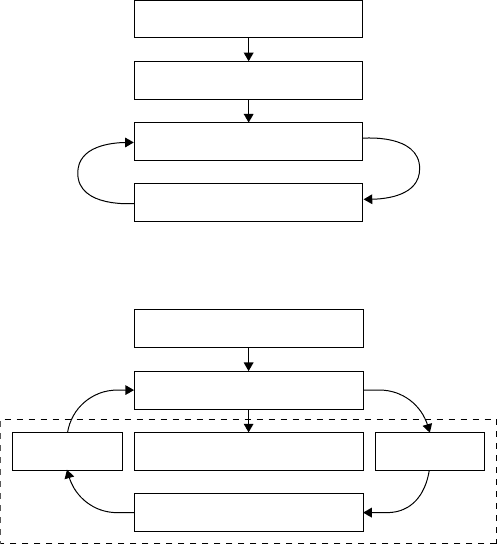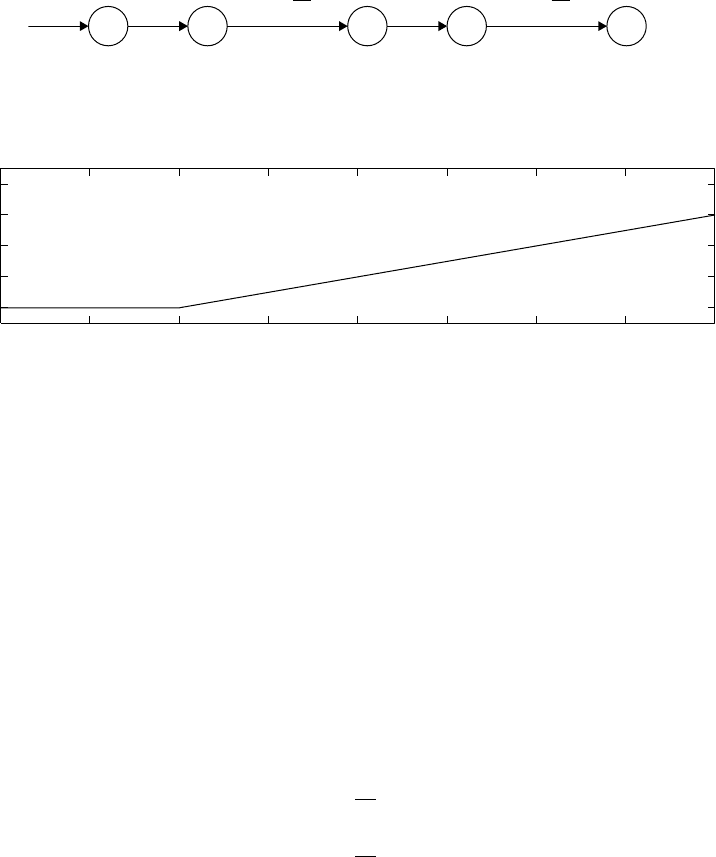Fishwick P.A. (editor) Handbook of Dynamic System Modeling
Подождите немного. Документ загружается.


34-6 Handbook of Dynamic System Modeling
Using Eq. (34.1) we calculate the mean flow time for workstation 0
ϕ
0
= ϕ
B
+t
0
=
c
2
a
+c
2
0
2
u
1 −u
t
0
+t
0
=
1 +0.5
2
0.75
1 −0.75
3.0 +3.0 =9.75 h
Using Eq. (34.2), we determine the coefficient of variation on the interarrival time c
a,1
for work-
station W
1
c
2
a,1
= c
2
d,0
= (1 −u
2
)c
2
a
+u
2
c
2
0
= (1 −0.75
2
)1 +0.75
2
·0.5 = 0.719
and the mean flow time for workstation 1
ϕ
1
=
0.719 +0.5
2
0.75
1 −0.75
3.0 +3.0 = 8.49 h
In a similar way, we determine that c
2
a,2
=0.596, ϕ
2
=7.93 h. We then calculate the mean total flow time
to be
ϕ
tot
= ϕ
0
+ϕ
1
+ϕ
2
= 26.2h
Note that the minimal flow time without variability (c
2
a
=c
2
0,i
=0) equals 9.0 h.
Eq. (34.1) and Eq. (34.2) are particular instances of a workstation consisting of a single machine. For
workstations consisting of m identical machines, in parallel the following approximations can be used:
ϕ
B
=
c
2
a
+c
2
0
2
u
√
2(m+1)−1
m(1 −u)
·t
0
(34.3)
c
2
d
= (1 −u
2
)c
2
a
+u
2
c
2
0
+
√
m −1
√
m
(34.4)
Note that in case m =1 these equations reduce to Eq. (34.1) and Eq. (34.2).
Once the mean flow time has been determined, a third basic relation from queueing theory, Little’s law
(Little, 1961), can be used for determining the mean wip level. Little’s law states that the mean wip level
(number of lots in a manufacturing system) w is equal to the product of the mean throughput δ and the
mean flow time ϕ, provided the system is in steady state
w = δϕ (34.5)
An example illustrates how Kingman’s equation and Little’s law can be used.
Example 3
Consider the system of Example 2 as depicted in Figure 34.6. From Example 34.3.2 we know that the
flow times for the three workstations are, respectively,
ϕ
0
= 9.75 h, ϕ
1
= 8.49 h, ϕ
2
= 7.93 h
Since the steady-state throughput was assumed to be δ =1/t
a
=1/4.0 =0.25 lots/h, we obtain via
Little’s law
w
0
= 0.25 ·9.75 = 2.44 lots
w
1
= 0.25 ·8.49 = 2.12 lots
w
2
= 0.25 ·7.93 = 1.98 lots
The above-mentioned relations are simple approximations that can be used for getting a rough idea about
the possible performance of a manufacturing system. These approximations are fairly accurate for high

Modeling and Analysis of Manufacturing Systems 34-7
degrees of utilization but less accurate for lower degrees of utilization. A basic assumption when using
these approximations is the independence of the interarrival times, which in general is not the case, e.g., for
merging streams of jobs. Furthermore, using these equations only steady-state behavior can be analyzed.
For studying things like ramp-up behavior or for incorporating more details like operator-behavior, more
sophisticated models are needed, as described in the next section.
34.4 Discrete-Event Models
In the previous section simple methods have been introduced for analyzing steady-state behavior of
manufacturing systems. For analyzing the dynamics of manufacturing systems, more sophisticated models
are required. Using Figure 34.3 in Section 34.2 it was illustrated that typical models of manufacturing
systems are the so-called discrete-event models. In this section, we present examples how to build a
discrete-event model of a manufacturing system using the specification language χ, explained in more
detail in Chapter 19 of this handbook.
The way to build a discrete-event model is to consider the manufacturing system as a network of
concurrent processes through which jobs and other types of information flows. For example, a basic
machine can be modeled as a process which repeatedly tries to receive a lot, waits for the period of time
(the process time), and tries to send a lot. Using χ, we can write
proc M(chan a?b! : lot, var t
e
:real)=|[var x : lot :: (a?x; t
e
; b!x)]|
The machine is able to receive lots via external channel a, is able to send lots via external channel b, and
the process time of the machine is given by parameter t
e
. Repeatedly, the machine tries to receive a lot over
external channel a and store this lot in discrete variable x. Next, the machine waits for t
e
, after which the
machine tries to send x via external channel b.
A buffer can be modeled as a process that may receive new lots if it is not full and may send lots if it is
not empty. Using χ, a finite first in, first out (FIFO) buffer with a maximal buffer size n can be modeled as
proc B (chan a?b! : lot, var n : nat) =
|[ disc xs : [lot] =[], x : lot
::(len(xs) < n →a?x; xs : =xs++[x]
[] len(xs) > 0 →b!hd(xs); xs : =tl(xs)
)
]|
This process can receive lots via external channel a, send lots via external channel b, and has its maximal
buffer size n as a parameter. Repeatedly, two alternatives can be executed:
•
Trying to receive a lot via channel a (only if the length of the list xs is less than n) into discrete
variable x and consecutively adding it to list xs of lots (using a concatenation of lists).
•
Trying to send the head of the list (its first element) via channel b (only if the list is not empty) and
consecutively reducing list xs to its tail (everything but the first element).
These two processes can be used to model a workstation that consists of a 3-place buffer and a machine
with process time t
e
by simply executing the two previously specified processes in parallel:
proc W (chan a?b! : lot, var t
e
: real) =|[chan c : lot :: B(a,c,3)M(c,b,t
e
)]|
We assume that lots arrive at this workstation according to a Poisson arrival process with mean arrival rate
of λ jobs per unit time. This can be modeled by means of the generator process
proc G (chan a! : lot, var λ : real) =
|[disc u: → real =exponential(1/λ)::(a!τ; σu; b!x)]|
Here the type lot is a real number which contains the time this lot entered the system. Generator G is able
to send lots via external channel a and has a mean departure rate, which is given by parameter λ.The

34-8 Handbook of Dynamic System Modeling
discrete variable u contains an exponential distribution with mean 1/λ. Repeatedly, the generator tries
to send a lot over external channel a, where at departure it gets assigned the current time τ. Next, the
generator waits for a period which is given by a sample from the distribution u.
Once a lot has been served by workstation W it leaves to the exit process E:
proc E(chan a? : lot) =|[var x : lot :: (a?x)]|
This process repeatedly tries to receive a lot via external channel a.
Foranarrivalrateofλ =0.5 and a process time of t
e
=1.5, the specification of the discrete-event model
can be completed by
model GWE() =|[chan a,b : lot :: G(a,0.5) W (a,b,1.5)E(b)]|
In this way a manufacturing system can be modeled as a network of concurrent processes through which
jobs and other types of information flows. The presented model is rather simple, but clearly many more
ingredients can be added. For example, to include an operator for the processing of the machine we can
modify the process M into
proc
¯
M (chan a?b! : lot, c?, d! : operator, var t
e
: real) =
|[var x : lot, y :operator::(c?y; a?x; t
e
; b!x; d!y)]|
Highly detailed models of manufacturing systems can be made in this way, even before the system has been
build. The influence of parameters can be analyzed by running several experiments with the discrete-event
model using different parameter settings. This is common practice when designing a several billion wafer
fab. However, since in practice manufacturing systems are changing continuously, it is very hard to keep
these detailed discrete-event models up-to-date.
Fortunately, for a manufacturing system in operation it is possible to arrive at more simple/less detailed
discrete-event models by using the concept of EPTs as introduced in the next section.
34.5 Effective Process Times
As mentioned in the previous section, for the processing of a lot at a machine, many steps may be required.
It could be that an operator needs to get the lot from a storage device, set up a specific tool that is required
for processing the lot, put the lot on an available machine, start a specific program for processing the lot,
wait until this processing has finished (meanwhile doing something else), inspect the lot to determine if all
went well, possibly perform some additional processing (e.g., rework), remove the lot from the machine
and put it on another storage device, and transport it to the next machine. At all of these steps something
might go wrong: the operator might not be available, after setting up the machine the operator finds out
that the required recipe cannot be run on this machine, the machine might fail during processing, no
storage device is available anymore so the machine cannot be unloaded and is blocked, etc.
It is impossible to measure all sources of variability that might occur in a manufacturing system. While
some of the sources of variability could be incorporated into a discrete-event model (tool failures and
repairs, maintenance schedules), not all sources of variability can be included. This is clearly illustrated in
Figure 34.7, obtained from Jacobs et al. (2003).
The left graph contains actual realizations of flow times of lots leaving a real manufacturing system,
whereas the right graph contains the results of a detailed deterministic simulation model and the graph in
the middle contains the results of a similar model including stochasticity. It turns out that in reality flow
times are much higher and much more irregular than simulation predicts. So, even if one tries hard to
capture all variability present in a manufacturing system, still the outcome predicted by the model is far
from reality.
The term EPT has been introduced by Hopp and Spearman (2000) as the time seen by lots from a
logistical point of view. To determine the EPT they assume that the contribution of the individual sources
of variability is known.

Modeling and Analysis of Manufacturing Systems 34-9
Exit time (days)
Manufacturing system Stochastic simulation Deterministic simulation
Flow time (days)
0 10 20 0 10 20 0 10 20
FIGURE 34.7 A comparison.
0 5 10 15 20 25 30
Machine breakdown
Waiting for operator
Queueing
Processing
Setup
Legend
FIGURE 34.8 Gantt chart of five lots at a single machine workstation.
A similar description is given in Sattler (1996) where the effective process time has been defined as all
flow time except waiting for another lot. It includes waiting owing to machine down time and operator
availability and a variety of other activities. In Sattler (1996) it was also noticed that this definition of
effective process time is difficult to measure.
Instead of taking the bottom-up view of Hopp and Spearman, a top-down approach can also be taken,
as shown by Jacobs et al. (2003), where algorithms have been introduced that enable determination of
effective process time realizations from a list of events.
We consider a single machine workstation and assume that the Gantt chart of Figure 34.8 describes a
given time period.
•
At t =0 the first lot arrives at the workstation. After a setup, the processing of the lot starts at t =2
and is completed at t =6.
•
At t =4 the second lot arrives at the workstation. At t =6 this lot could have been started, but
apparently there was no operator available, so only at t =7 the setup for this lot starts. Eventually,
at t =8 the processing of the lot starts and is completed at t =12.
•
The fifth lot arrives at the workstation at t =22, processing starts at t =24, but at t =26 the machine
breaks down. It takes until t =28 before the machine has been repaired and the processing of the
fifth lot continues. The processing of the fifth lot is completed at t =30.
From a lot’s point of view we observe:
•
The first lot arrives at an empty system at t =0 and departs from this system at t =6. Its processing
took 6 units of time.
•
Thesecondlotarrivesatanonemptysystematt =4 and needs to wait. At t =6, the system becomes
available again and hence from t =6 on there is no need for the second lot to wait. At t =12 the

34-10 Handbook of Dynamic System Modeling
0 5 10 15 20 25 30
EPT 1 EPT 2 EPT 3 EPT 4 EPT 5
Machine breakdown
Waiting for operator
Queueing
Processing
Setup
Legend
FIGURE 34.9 EPT realizations of five lots at a workstation.
second lot leaves the system, so from the point of view of this lot, its processing took from t =6 till
t =12; the lot does not know whether waiting for an operator and a setup is part of its processing.
•
The third lot sees no need for waiting after t =12 and leaves the system at t =17, so it assumes to
have been processed from t =12 till t =17.
Following this reasoning, the resulting effective process times for lots are as depicted in Figure 34.9.
Note that only arrival and departure events of lots to a workstation are needed for determining the
effective process times. Furthermore, none of the contributing disturbances needs to be measured. In
highly automated manufacturing systems, arrival and departure events of lots are being registered, so for
these manufacturing systems, effective process time realizations can be determined rather easily. These
EPT realizations can be used in a relatively simple discrete-event model of the manufacturing system.
Such a discrete-event model only contains the architecture of the manufacturing system, buffers, and
machines. The process times of these machines are samples from their EPT distribution as measured
from real manufacturing data. There is no need for incorporating machine failures, operators, etc., as
this is all included in the EPT-distributions. Furthermore, the EPTs are utilization independent. That
is, EPTs determined collected at a certain throughput rate are also valid for different throughput rates.
Also, machines with the same EPT-distribution can be added to a workstation. This makes it possible
to study how the manufacturing system responds in case a new machine is added, or all kinds of other
what-if-scenarios. Finally, since EPT-realizations characterize operational time variability, they can be
used for performance measuring. For more on this issue, the interested reader is referred to Jacobs et al.
(2003, 2006). What is most important is that EPTs can be determined from real manufacturing data and
yield relatively simple discrete-event models of the manufacturing system under consideration. These
relatively simple discrete-event models can serve as a starting point for controlling manufacturing systems
dynamically.
34.6 Control of Manufacturing Systems: A Framework
In the previous section, the concept of effective process times has been introduced as a means to arrive
at relatively simple discrete-event models for manufacturing systems, using measurements from the real
manufacturing system under consideration. The resulting discrete-event models are large queueing net-
works which capture the dynamics reasonably well. These relatively simple discrete-event models are not
only a starting point for analyzing the dynamics of a manufacturing system, but can also be used as a
starting point for controller design. If one is able to control the dynamics of the discrete-event model of
the manufacturing system, the resulting controller can also be used for controlling the real manufacturing
system.
Even though control theory exists for controlling discrete-event systems, unfortunately none of it is
appropriate for controlling discrete-event models of real-life manufacturing systems. This is mainly due
to the large number of states of a manufacturing system. Therefore, a different approach is needed.

Modeling and Analysis of Manufacturing Systems 34-11
Manufacturing system
Discrete event model
Approximation model
Controller
FIGURE 34.10 Control framework (I).
Manufacturing system
Discrete event model
Approximation model
Controller
ConversionConversion
FIGURE 34.11 Control framework (II).
If we concentrate on mass production, the distinction between lots is not really necessary and lots
can be viewed in a more continuous way. Therefore, instead of the discrete-event model we consider an
approximation model.
Using the approximation model, we can use standard control theory to derive a controller for the
approximation model (cf. Figure 34.10).
When the closed-loop system of the approximation model and the controller behaves as desired, the
controller can be connected to the discrete-event model. However, since the derived controller is not a
discrete-event controller its control actions still need to be transformed into events. It might very well
be that the optimal control action would be to produce 2.75 lots during the next shift. One still needs
to decide how many jobs to really start (2 or 3), and also when to start them. This is the left conversion
block in Figure 34.11. Similarly, a conversion is needed from discrete-event model to controller: a simple
conversion would be to sample the discrete-event model once every shift, but other sampling strategies
might also be followed. For example, if at the beginning of a shift a machine breaks down it might not be
such a good idea to wait until the end of the shift before setting new production targets.
Once the two conversion blocks have been properly designed a suitable discrete-event controller for the
discrete-event model is obtained, as illustrated in Figure 34.11 (dashed).
Eventually, as a final step, the designed controller can be disconnected from the discrete-event model,
and attached to the real manufacturing system.
In the presented control framework two crucial steps can be distinguished. First, the discrete-event
model should be a good enough approximation of the real manufacturing system, i.e., the model needs to
be validated and if found unsatisfactory it needs to be improved. Second, the approximation model should
be a good enough approximation of the discrete-event model, or actually, of the discrete-event model
and conversion block(s), since that is the system that needs to be controlled by the continuous controller.
Depending on the variables of interest, a valid approximation model needs to be used. An overview of

34-12 Handbook of Dynamic System Modeling
common used approximation models, assuming mass production, is provided in the next two sections.
In Section 34.7 approximation models are presented that mainly focus on throughput. In Section 34.8
approximation models are presented that incorporate both throughput and flow time, taking into account
the nonlinear relations as depicted in Figure 34.2.
34.7 Standard Fluid Model and Extensions
The analytical approximations models of Section 34.3 are only concerned with steady state, no dynamics
is included. This disadvantage is overcome by discrete-event models as discussed in Section 34.4. However,
since they model each job separately and stochastically long simulation times are required for obtaining
satisfactory results. Using an approximation model where jobs are viewed in a continuous way we can
overcome these long simulation times.
34.7.1 A Common Fluid Model
The current standard way of deriving fluid models is most easily explained by means of an example.
Consider a simple manufacturing system consisting of two machines in series, as displayed in Figure 34.12.
Let u
0
(t) denote the rate at which jobs arrive at the system at time t, u
i
(t) the rate at which machine M
i
produces lots at time t, y
i
(t) the number of lots in buffer B
i
at time t (i ∈{1, 2}), and y
3
(t) the number of
lots produced by the manufacturing system at time t. Assume that machines M
1
and M
2
have a maximum
capacity of µ
1
and µ
2
lots per time unit, respectively.
The rate of change of the buffer contents is given by the difference between the rates at which lots enter
and leave the buffer. Under the assumption that the number of lots can be considered continuously, we get
˙y
1
(t) = u
0
(t) −u
1
(t),
˙y
2
(t) = u
1
(t) −u
2
(t),
˙y
3
(t) = u
2
(t)
(34.6)
which can be rewritten as
˙x(t) =
⎡
⎣
000
000
000
⎤
⎦
x(t) +
⎡
⎣
1 −10
01−1
00 1
⎤
⎦
u(t) (34.7a)
y(t) =
⎡
⎣
100
010
001
⎤
⎦
x(t) +
⎡
⎣
000
000
000
⎤
⎦
u(t) (34.7b)
where u =[u
0
, u
1
, u
2
]
and y =[y
1
, y
2
, y
3
]
. We also have capacity constraints on the input as well as the
constraint that the buffer contents should remain positive, i.e.,
0 ≤ u
1
(t) ≤ µ
1
,0≤ u
2
(t) ≤ µ
2
and y
1
(t) ≥ 0, y
2
(t) ≥ 0, y
3
(t) ≥ 0 (34.8)
This system is a controllable linear system of the form ˙x =Ax +Bu, y =Cx +Du, extensively studied in
control theory.
B
1
M
1
B
2
M
2
B
3
u
0
u
1
u
1
u
2
u
2
y
1
y
2
y
3
FIGURE 34.12 A simple manufacturing system.

Modeling and Analysis of Manufacturing Systems 34-13
Note that instead of a description in continuous time, a description in discrete time can also be used:
˙x(k +1) =
⎡
⎣
100
010
001
⎤
⎦
x(k) +
⎡
⎣
1 −10
01−1
001
⎤
⎦
u(k) (34.9a)
y(k) =
⎡
⎣
100
010
001
⎤
⎦
x(k) +
⎡
⎣
000
000
000
⎤
⎦
u(k) (34.9b)
Also, the description of Eq. (34.7) is not the only possible input/output/state model that yields the
input/output behavior Eq. (34.6). To illustrate this, consider the change of coordinates
x(t) =
⎡
⎣
1 −10
01−1
001
⎤
⎦
¯x(t) (34.10)
which results in the following input/output/state model:
¯x(t) =
⎡
⎣
000
000
000
⎤
⎦
¯x(t)
+
⎡
⎣
100
010
001
⎤
⎦
u(t) (34.11a)
y(t) =
⎡
⎣
1 −10
01−1
001
⎤
⎦
¯x(t) +
⎡
⎣
000
000
000
⎤
⎦
u(t) (34.11b)
Note that in this description, the state ¯x denotes the cumulative production at each workstation.
We would like to study the response of the output of the system Eq. (34.7), or equivalently Eq. (34.11).
Assume we initially start with an empty production line (i.e., x(0) =0), that both machines have a capacity
of 1 lot per unit time (i.e., µ
1
=µ
2
=1) and that we feed the line at a rate of 1 lot per time unit (i.e.,
u
0
=1). Furthermore, assume that machines produce at full capacity, but only in case something is in the
buffer in front of it, i.e.,
u
i
(t) =
⎧
⎨
⎩
µ
i
if y
i
(t) > 0
i ∈{1, 2}
0 otherwise
(34.12)
Under these assumptions, the resulting contents of buffer B
3
are as displayed in Figure 34.13. Note that
immediately lots start coming out of the system. Clearly, this is not what happens in practice. Since both
machines M
1
and M
2
need to process the first lot, it should take the system at least (1/µ
1
) +(1/µ
2
) time
0 1 2 3 4 5 6 78
0
2
4
6
8
System response
Time
y
3
FIGURE 34.13 Output of the manufacturing system using model Eq. (34.6).

34-14 Handbook of Dynamic System Modeling
B
1
M
1
B
2
M
2
B
3
u
0
(t)
y
1
(t)
u
1
(t) u
2
(t)
y
2
(t) y
3
(t)
u
1 冸
t
冹
m
1
1
u
2 冸
t
冹
m
2
1
FIGURE 34.14 A simple manufacturing system revisited.
0 1 2 3 4 5 6 78
0
2
4
6
8
System response
Time
y
3
FIGURE 34.15 Output of the manufacturing system using model Eq. (34.13).
units before lots can come out. This illustrates fluid models as given by Eq. (34.7) or Eq. (34.11) do not
incorporate flow times.
34.7.2 An Extended Fluid Model
In the previous subsection, we noticed that in the standard fluid model lots immediately come out of the
system, once we start producing. A way to overcome this problem is to explicitly take into account the
required delay. Whenever we decide to change the production rate of machine M
1
, buffer B
2
notices this
1/µ
1
time units later. As a result, the rate at which lots arrive at buffer B
2
at time t is equal to the rate
at which machine M
1
was processing at time t −1/µ
1
. This observation results in the following model
(see also Figure 34.14):
˙y
1
(t) = u
0
(t) −u
1
(t)
˙y
2
(t) = u
1
t −
1
µ
1
−u
2
(t)
˙y
3
(t) = u
2
t −
1
µ
2
(34.13)
Clearly, the constraints of Eq. (34.8) also apply to the model given by Eq. (34.13).
Figure 34.15 shows the response of the system given by Eq. (34.12) to the ramp-up experiment that lead
to Figure 34.13. Comparing these two figures we see that no products enter buffer B
3
during the first 2.0
time units for the extended fluid model. Clearly, the extended fluid model produces more realistic results
than the standard fluid model.
34.7.3 An Approximation to the Extended Fluid Model
In the previous subsection, we proposed an extended version of the standard fluid model. Although the
model of Eq. (34.13) still is a linear model, standard linear control theory is not able to deal with this
model, due to the time delay. Instead we have to rely on control theory of infinite-dimensional linear
systems (see, e.g., Curtain and Zwart, 1995).

Modeling and Analysis of Manufacturing Systems 34-15
012345678
0
2
4
6
8
System response
Time
y
3
FIGURE 34.16 Output of the manufacturing system using model Eq. (34.14).
Another possibility would be to approximate the time delays by means of a Padé approximation (Baker,
1965). Using a second-order Padé approximation, the model of Eq. (34.13) can be approximated as:
˙x =
⎡
⎢
⎢
⎢
⎢
⎢
⎢
⎢
⎢
⎣
0000 0 00
0000 0 00
0046−30 0
0004000
0000 0 00
0000 46−3
0000040
⎤
⎥
⎥
⎥
⎥
⎥
⎥
⎥
⎥
⎦
x +
⎡
⎢
⎢
⎢
⎢
⎢
⎢
⎢
⎢
⎣
100
010
000
000
001
000
000
⎤
⎥
⎥
⎥
⎥
⎥
⎥
⎥
⎥
⎦
u (34.14a)
y =
⎡
⎣
1 −1 00 0 00
01−30−1 00
0000 1 −30
⎤
⎦
x +
⎡
⎣
000
000
000
⎤
⎦
u (34.14b)
Note the structure in Eq. (34.14). In bold face we can easily recognize the dynamics of Eq. (34.11). The
additional dynamics results from the Padé approximation.
If we initiate the system of Eq. (34.14) from x(0) =0 and feed it at a rate u
0
=1 while using Eq. (34.12),
we obtain the system response as depicted in Figure 34.16. It is clear that we do not get the same response
as in Figure 34.15, but the result is rather acceptable from a practical point of view. At least it is closer to
reality than the response displayed in Figure 34.13.
34.7.4 A Hybrid Model
In the previous subsections, we provided extensions to the standard fluid model by taking into account
the time delay lots encounter owing to the processing of machines. We also mentioned the constraints of
Eq. (34.8) that have to be obeyed. These are constraints that we have to take into account when designing
a controller for our manufacturing system. The way we dealt with these constraints in the previous
subsections was by requiring the machines to produce only in case the buffer contents in front of that
machine were positive (cf. Eq. 34.12).
A way to extend the standard fluid model Eq. (34.7) is to think of these constraints in a different way. As
illustrated in Subsection 34.7.1, when we turn on both machines, immediately lots start coming out of the
system. This is an undesirable feature that we would like to avoid. In practice, the second machine can only
start producing when the first machine has finished a lot. Keeping this in mind, why do we allow machine
M
2
to start producing as soon as the buffer contents of the buffer in front of it are positive? Actually,
machine M
2
should only start producing as soon as a whole product has been finished by the machine M
1
.
